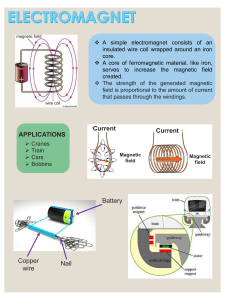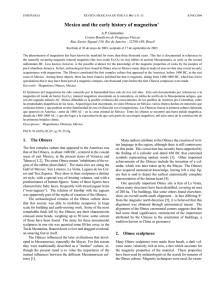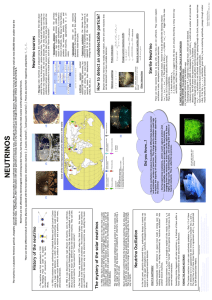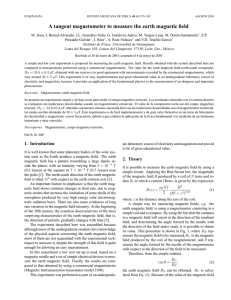Effective magnetic moment of neutrinos in strong - E
Anuncio
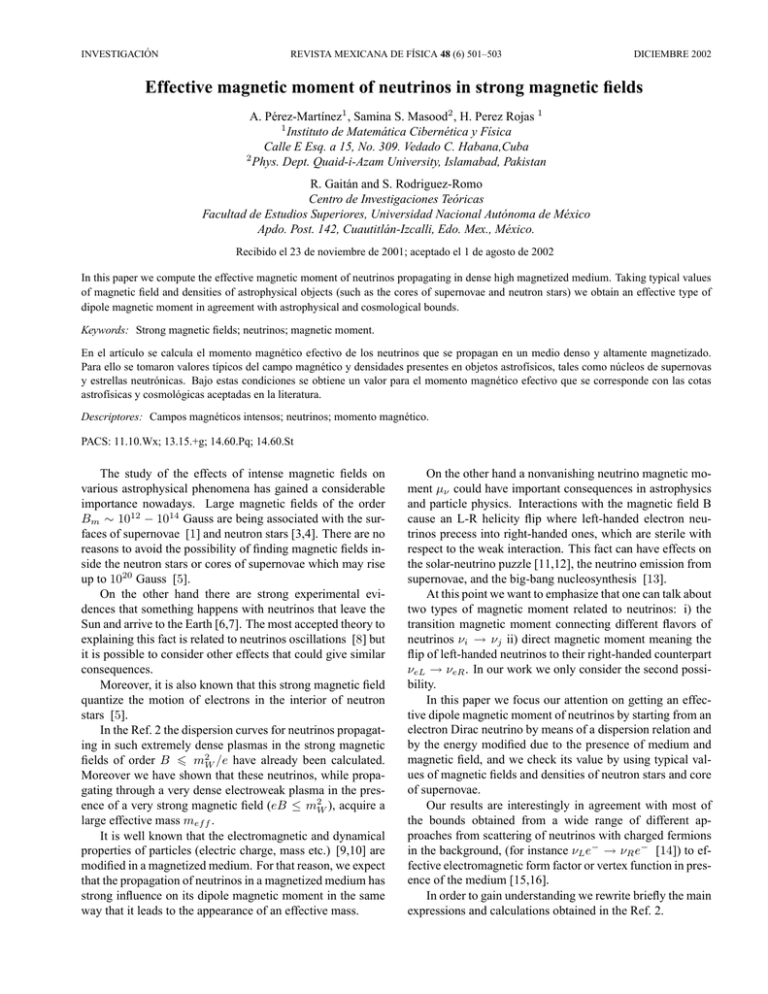
INVESTIGACIÓN
REVISTA MEXICANA DE FÍSICA 48 (6) 501–503
DICIEMBRE 2002
Effective magnetic moment of neutrinos in strong magnetic fields
A. Pérez-Martı́nez1 , Samina S. Masood2 , H. Perez Rojas 1
1
Instituto de Matemática Cibernética y Fı́sica
Calle E Esq. a 15, No. 309. Vedado C. Habana,Cuba
2
Phys. Dept. Quaid-i-Azam University, Islamabad, Pakistan
R. Gaitán and S. Rodriguez-Romo
Centro de Investigaciones Teóricas
Facultad de Estudios Superiores, Universidad Nacional Autónoma de México
Apdo. Post. 142, Cuautitlán-Izcalli, Edo. Mex., México.
Recibido el 23 de noviembre de 2001; aceptado el 1 de agosto de 2002
In this paper we compute the effective magnetic moment of neutrinos propagating in dense high magnetized medium. Taking typical values
of magnetic field and densities of astrophysical objects (such as the cores of supernovae and neutron stars) we obtain an effective type of
dipole magnetic moment in agreement with astrophysical and cosmological bounds.
Keywords: Strong magnetic fields; neutrinos; magnetic moment.
En el artı́culo se calcula el momento magnético efectivo de los neutrinos que se propagan en un medio denso y altamente magnetizado.
Para ello se tomaron valores tı́picos del campo magnético y densidades presentes en objetos astrofı́sicos, tales como núcleos de supernovas
y estrellas neutrónicas. Bajo estas condiciones se obtiene un valor para el momento magnético efectivo que se corresponde con las cotas
astrofı́sicas y cosmológicas aceptadas en la literatura.
Descriptores: Campos magnéticos intensos; neutrinos; momento magnético.
PACS: 11.10.Wx; 13.15.+g; 14.60.Pq; 14.60.St
The study of the effects of intense magnetic fields on
various astrophysical phenomena has gained a considerable
importance nowadays. Large magnetic fields of the order
Bm ∼ 1012 − 1014 Gauss are being associated with the surfaces of supernovae [1] and neutron stars [3,4]. There are no
reasons to avoid the possibility of finding magnetic fields inside the neutron stars or cores of supernovae which may rise
up to 1020 Gauss [5].
On the other hand there are strong experimental evidences that something happens with neutrinos that leave the
Sun and arrive to the Earth [6,7]. The most accepted theory to
explaining this fact is related to neutrinos oscillations [8] but
it is possible to consider other effects that could give similar
consequences.
Moreover, it is also known that this strong magnetic field
quantize the motion of electrons in the interior of neutron
stars [5].
In the Ref. 2 the dispersion curves for neutrinos propagating in such extremely dense plasmas in the strong magnetic
fields of order B 6 m2W /e have already been calculated.
Moreover we have shown that these neutrinos, while propagating through a very dense electroweak plasma in the presence of a very strong magnetic field (eB ≤ m2W ), acquire a
large effective mass mef f .
It is well known that the electromagnetic and dynamical
properties of particles (electric charge, mass etc.) [9,10] are
modified in a magnetized medium. For that reason, we expect
that the propagation of neutrinos in a magnetized medium has
strong influence on its dipole magnetic moment in the same
way that it leads to the appearance of an effective mass.
On the other hand a nonvanishing neutrino magnetic moment µν could have important consequences in astrophysics
and particle physics. Interactions with the magnetic field B
cause an L-R helicity flip where left-handed electron neutrinos precess into right-handed ones, which are sterile with
respect to the weak interaction. This fact can have effects on
the solar-neutrino puzzle [11,12], the neutrino emission from
supernovae, and the big-bang nucleosynthesis [13].
At this point we want to emphasize that one can talk about
two types of magnetic moment related to neutrinos: i) the
transition magnetic moment connecting different flavors of
neutrinos νi → νj ii) direct magnetic moment meaning the
flip of left-handed neutrinos to their right-handed counterpart
νeL → νeR . In our work we only consider the second possibility.
In this paper we focus our attention on getting an effective dipole magnetic moment of neutrinos by starting from an
electron Dirac neutrino by means of a dispersion relation and
by the energy modified due to the presence of medium and
magnetic field, and we check its value by using typical values of magnetic fields and densities of neutron stars and core
of supernovae.
Our results are interestingly in agreement with most of
the bounds obtained from a wide range of different approaches from scattering of neutrinos with charged fermions
in the background, (for instance νL e− → νR e− [14]) to effective electromagnetic form factor or vertex function in presence of the medium [15,16].
In order to gain understanding we rewrite briefly the main
expressions and calculations obtained in the Ref. 2.
502
A. PÉREZ-MARTÍNEZ, SAMINA S. MASOOD, H. PEREZ ROJAS R. GAITÁN, AND S. RODRIGUEZ-ROMO
We work in the framework of imaginary time formalism
and replace the vacuum propagators with the corresponding
background corrected propagators in presence of strong magnetic fields. All the Feynman rules of the vacuum theory remain the same, otherwise.
The effect of the medium is taken into account through
Ge (x, x0 ) = −
the solution of the dispersion equation and the presence of
the magnetic field is considered via propagators of electrons
and W-bosons.
The electron propagator in the configuration space with
the background corrections turns out to be [9]
∞ XZ
X
1
dp3 dp2
2
2
∗
2
(2π )β 0
(p4 + p3 + m2e + 2eBn0 )
n =0 p4
× {(ip∗4 γ4 + ip3 γ3 − me )(σ+ ψn0 (ξ)ψn0 (ξ 0 ) + σ− ψn0 −1 (ξ)ψn0 −1 (ξ 0 ))
0
1√
(1)
2eBn0 [γ+ ψn0 (ξ)ψn0 −1 (ξ 0 ) − γ− ψn0 −1 (ξ)ψn0 (ξ 0 )]} exp[ip4 (x4 − x04 ) + ip3 (x3 − x03 ) + ip2 (x2 − x2 )],
2
√
√
p2
where ξ = eB(x1 + xo ), ξ 0 = eB(x01 + xo ), xo = eB
, σ ± = 1/2[1 ± σ3 ], γ± = 1/2[γ1 ± iγ2 ], σ3 = i/2[γ1 , γ2 ],
∗
0
pλ = pλ − iµδ4λ , n is the electron Landau quantum number and ψn0 (ξ) are Hermite functions for Aµ = (0, Bx, 0, 0). The
W-boson propagator in the magnetic field has the form
+
0
W
Dµν
(x, x )
XXZ
1
R− + R+ 1
(R− − R+ ) 3
0 2
=
dp
dp
[
Ψ
+
R
Ψ
+
i
Ψµν )]
2
3
µν
µν
(2π)2 β p n
2
2
4
×ψn (ξ)ψn (ξ 0 )exp[ip4 (x4 − x04 ) + ip3 (x3 − x03 ) + ip2 (x2 − x02 )].
(2)
where n is the W Landau quantum number,
2
R± = [p∗4 + EnW2 ± 2eB]−1 ,
W2 −1
R0 = [p∗2
,
4 + En ]
with
2
EnW2 = MW
+ p23 + 2eB(n + 1/2);
Ψ1µν =
1 02
G ,
B 2 µν
1
1
and Ψ3µν = G0µν
= δµν − 2 G02
µν
B
B
is
the
field
tensor
of
the
SU
(2)
×
U
(1)
electromagnetic
(G02
µν
external field). Concerning the gauge fixing term, we are takW
ing Dµν
in a transverse gauge which is expected to guarantee the gauge independence of the neutrino spectrum. The
charged current contribution to the self-energy of neutrino is
in the special case of strong magnetic fields, which means
that the Landau ground state for electrons and W-bosons are
dominant, we can get a not trivial expression for the energy
of neutrino quasiparticles as a function of the magnetic field
and the electron density Ne [2], giving
ω=
Ψ2µν
ΣC (x, x0 ) = −i
g2
W
γµ Ge (x, x0 )Dµν
(x − x0 )γν ;
(2π)3
(3)
the solution of this equation can be calculated from the inverse propagator of the neutrino in the momentum space
given by
g 2 eB
(2π)2
µXZ
×
∆ω =
p4
where PL is the usual left projection operator. By solving
det(−iγµ kµ + ΣC ) = 0,
(5)
(6)
where Ne is related to the chemical potential νe and mag2
netic field B by µp
e = Ne /(2π) eB [2]. The expression (6)
2
is valid whenever MW − eB >> µe and for a wide range
of values of B and T .
In Fig. 1 we plot the behavior of ω respect to B. Let us
remark that this quantity increase very fast when eB → m2W .
The value of this field is 1024 Gauss. For fields under 1023
Gauss ω is practically constant and its values is given by (8)
as we can see below.
For eB << m2W we can expand Eq. (6) and get the expression
ΣC (k) =
¶
dp3 Goe (p3 + k3 , p4 + k4 )Σαβ PL , (4)
g 2 Ne
,
m2W − e|B|
g 2 Ne
g 2 Ne eB
+
.
m2W
m4W
(7)
The first term of Eq. (7) represents an effective mass dependent on the electron density, for magnetic fields B < Bc
(where Bc = m2W /e) which is of order 250 eV for
Ne = 1039 cm−3 . The second term contains the dipole
moment contribution [17], i.e. the effective dipole moment is
Rev. Mex. Fı́s. 48 (6) (2002) 501–503
EFFECTIVE MAGNETIC MOMENT OF NEUTRINOS IN STRONG MAGNETIC FIELDS
F IGURE 1. Behavior of the energy ω as a function of B.
µef f =
g 2 Ne e
.
m4W
(8)
When we evaluate it for the same density, typical in cores
of supernovae, we get µef f ≈ 0.36 × 10−12 µB . This value
of the effective magnetic dipole moment of neutrinos is in
agreement with astrophysical bounds [14,15].
Bounds of this order for the magnetic moment provides
the possibility of direct transition of dipole moment which
even could be a solution of the puzzle of SNP because the
sunspot may give evidences of magnetic fields closer to 105
1. V. Ginzburg, High Energy Gamma Ray Astrophysics (North
Holland, Amsterdamm, 1991)
2. A. Pérez Martı́nez, H. Pérez Rojas, D. Oliva, A. Amézaga and
R. Rodriguez Romo, Int. J. of Mod. Phys. A 15 (2000) 523.
3. I. Fushiki, E.H Crudmundsson and C.J.Pethick, Astrophys. J.
342 (1989) 958.
4. C. Woltzer, Astrophys. J. 140 (1964) 1309; J. Trumper et al.,
Astrophys. J. Lett. 219 (1978) 105; G. Ohanmugam, Ann. Rev.
Astron. Astrophys. 30 (1992) 143.
5. S. Chakrabarti, D. Bandyopadhyay and S. Pal, Phys. Rev. Lett.
78 (1997) 2898.
6. ”Atmospheric Neutrino Results from Superkamiokande Evidence for νµ − ντ Oscillations” Neutrino’98, Tokayama, Japan
(1998).
7. Q.R. Ahmad et al., Phys. Rev. Lett. 87 (2001) 071301.
8. S.P. Mikheyev, A. Smirnov, Sov. J. Nucl. Phys. 42 (1985) 913.
503
Gauss , this might produce spin-flip transitions of neutrinos
in spite of µν ≈ O(10−12 µB ) [12].
Our study at this level cannot be applied to the Sun because the relation between electron density and magnetic
field inside it implies that we must consider Landau level occupation of above the ground state.
Let us remark that the assumption of considering only
the first Landau level for electron and W-bosons is compatible with magnetic fields B ≥ 1017 Gauss. There are claims
that such large magnetic fields can exist in the cores of the
supernovae or neutron stars [5].
To conclude, we have shown that the solution of the dispersion equation in a magnetized dense plasma, gives information about the effective magnetic dipole moment which
could allow conversion of νL into νR . This effect is extremely smaller than the mass-density effect, mef f ≈ 250
eV and for B ≈ 1018 Gauss, µef f B ≈ 0.35 × 10−15 eV.
Acknowledgments
Two of us (S.M and A.P.M) would like to acknowledge the
support by Abdus Salam ICTP. A.P.M, H.P.R and R. Gaitán
thank ICTP for its support through the Caribbean Network on
Quantum Mechanics Particles and Fields.
9. H. Perez Rojas and A. Shabad, Ann. Phys. 138 (1982) 1.
10. K. Enquist, P. Olesen and V. Semikoz, Phys. Rev. Lett. 69
(1992) 2157.
11. M. Voloshin, M. Vysotskii and L. B. Okun, Sov. J. Nucl. Phys.
44 (1986) 544.
12. J. Pulido hep-ph/0106201; hep-ph/010116; J. Pulido E. Kh
Akhmedov, Astroparticle Physics 13 (2000) 227.
13. S. Nussinov and Y. Rephaeli, Phys. Rev. D 36 (1987) 2278.
14. R. Barbieri and R.N. Mohapatra, Phys. Rev. Lett. 61 (1988) 27.
15. A. Ayala, J. C. D’Olivo, and M. Torres, Phys. Rev. D 59 (1999)
111901.
16. Samina Masood, Astroparticle Phys. 4 (1995) 189 and references therein. Samina S.Masood, Proceedings of International
Europhysics Conference, Brussels, Belgium, 524 (1995)
17. P. Elmfors, D. Persson and Bo-Sture Skagerstam, Nucl. Phys. B
464 (1996) 153.
Rev. Mex. Fı́s. 48 (6) (2002) 501–503
